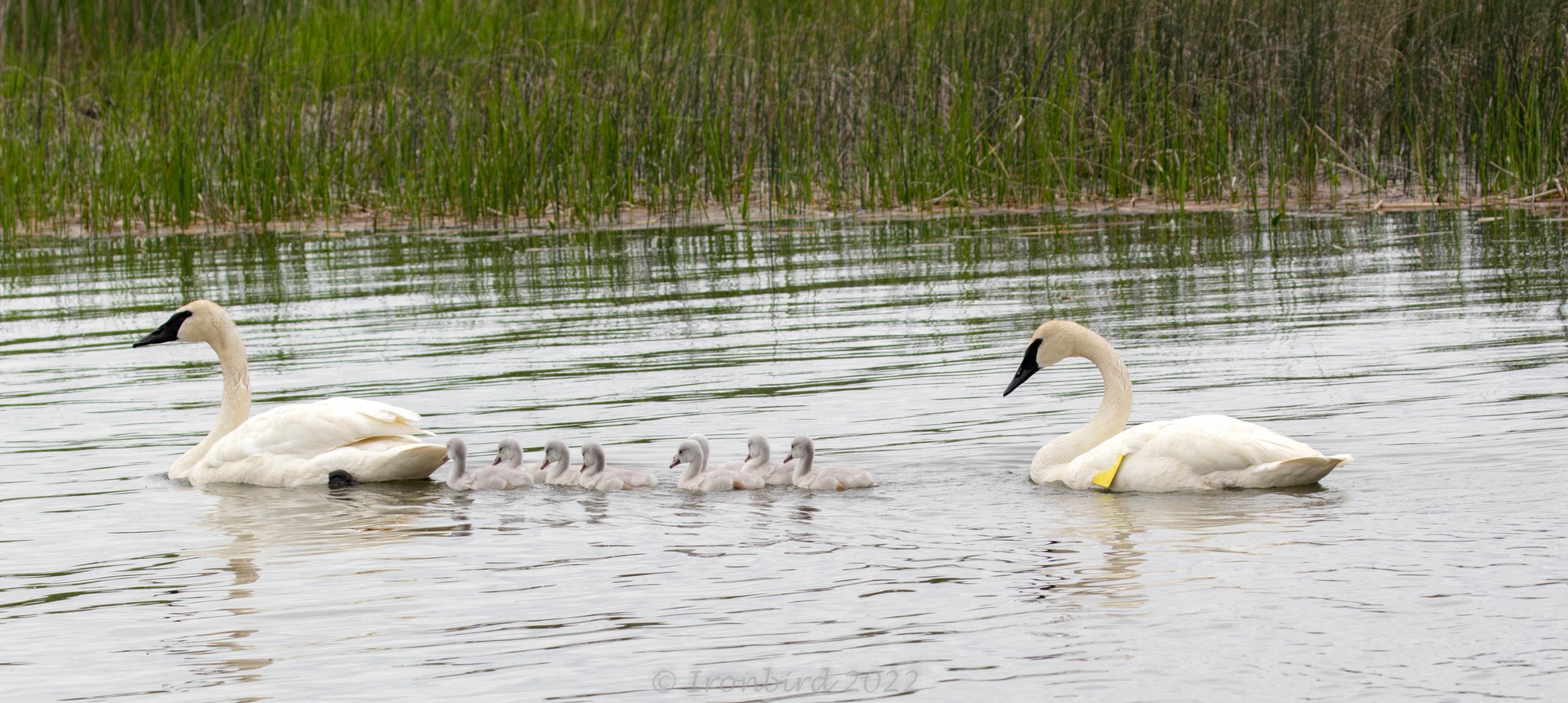Trumpeter Swan Conservation Ontario
Registered Name: Trumpeter Swan Conservation Ontario
Business No: 118785518RR0001
This organization is designated by Canada Revenue Agency (CRA) as a registered charity. They comply with the CRA's requirements and have been issued a charitable registration number.
This charity is fully set up with CanadaHelps, allowing for faster donation processing and access to more features
Trumpeter Swan Conservation Ontario was formerly known as Amherst Wildlife Foundation

Ensuring the Continuing Existence of Wild Trumpeter Swans in Ontario for Generations to Come.
The story of Ontario’s Trumpeter Swans begins with the tragedy of their extirpation in Ontario by the end of the 19th century. The introduction of guns accelerated the increased hunting pressure by humans on the population. Demand for their feathers, skins and meat brings the existence of the Trumpeter Swan in Ontario to a close in 1886 when the last reported Trumpeter Swan is shot at Long Point, Lake Erie. By 1932, surveys reported the North American population were in a critical state with only small pocketed populations totaling 69 swans in North America. These swans were only saved from extinction due to the introduction and protection of the Migratory Bird Treaty Act of 1918. In the 1930’s conservation and early restoration efforts began to save the critically endangered populations and their habitats. By the 1950’s positive population growth resulted from these conservation efforts. In the mid 1950's there was a discovery of a previously unknown breeding population of Trumpeters in Alaska and Western Canada. These Alaskan Trumpeters would eventually help build the foundation for the Trumpeters in Ontario and provide genetic diversity to the restored population. Fast Forward to 1982 when Ontario joins the restoration efforts.
Retired MNR biologist Harry G. Lumsden, spearheads the Ontario Trumpeter Swan Restoration Program. The objective is to restore the Trumpeter Swan in Ontario to its former range. Breeding pairs are purchased from other programs and 50 Alaskan eggs are collected in conjunction with US Fish and Wildlife Services. Funding comes from 94 different foundations, businesses, and individuals. Partnerships are founded with cooperators who volunteered to host captive breeding pairs and raise cygnets in large ponds on their properties. Cygnets would then be given to the restoration program for later release. It would take at least 4 years for the cygnets to be old enough to mate. Over the years, 574 captive reared swans are released into the wild in over 50 different locations throughout the province. Historical data collected provided the evidence required for selecting key release sites. One of the largest release sites was the Wye Marsh in Midland, Ontario. The coastal Georgian Bay wetlands would provide extensive pristine habitat for the swans.
1988, the Wye Marsh received their first captive breeding pair from the Ontario Trumpeter Swan Restoration program. In 1993 a milestone is reached in the program, one of their offspring successfully nested at the marsh. This swan known as “Pig Pen” would be the first wild Trumpeter Swan known to naturally nest in the Ontario wild in over 100 years. Pig Pen went on to produce 70+ wild descendants.
To measure the success of the reintroduction, Lumsden and his team applied leg bands and yellow wing markers to as many of the swans as possible. The program has marked 2,500+ swans over the past 30 years. Marking the swans enables the program to track and collect population statistics on the swans and their descendants. To date, with the assistance of volunteers and public reports the program has collected over 294,000 sighting reports for Ontario’s Trumpeters. Web based tools like Facebook, Instagram, Twitter, Ebird, and INaturalist have given momentum to the number of sightings that are now coming in annually. Today, the program has come a long way, from 1990 with only 300 sighting reports for 24 swans in 30 locations to 2021 when we recorded over 32,000 sightings, encompassing 800 marked swans, to be seen in 2,600 unique locations throughout Ontario, plus, 32 Ontario tagged swans were reported at 35 unique locations within the USA. In 1990, there is no wild nesting swans in Ontario, 2021 figures recorded 155 known nesting pairs, producing 528 hatched cygnets of which 318 cygnets were known to have fledged. This did not all happen by chance. A small group of dedicated volunteers from the first days of the restoration program to the continuing efforts of today are all part of our team. Countless hours have been spent to observe, band, rescue, report, record, and raise awareness by educating people about Ontario's Trumpeter Swans. What has been accomplished today could not have been done without the teams dedicated support and the assistance of the generosity of the general public. People can make a difference.
The early years of the restoration program were not without their challenges. Restoring a population of swans absent from the province for 100 years had its learning curves. It would take time to find solutions. Lead Poisoning became a key concern with swan losses, action was needed. Swans were dying after consuming lead shot while naturally foraging. The program joined forces with others and successfully advocated for the ban of lead shot in waterfowl hunting. In 1991, legislation was enacted to ban the use of lead shot for migratory bird hunting. Lead poisoning still continues to be one of the biggest concerns to the population, the old residual shot remains in the silty bottom sediment of our waters. Today, however, as many swans will die by ingesting fishing tackle containing lead as well as the old residual shot. Lead fishing gear such as, split shots, sinkers, and jig heads, resemble the pebbles they ingest to help break down food. They cannot tell the difference between a pebble or a lead sinker, they ingest these lead pebbles that will gradually dissolves in their system, they suffer a very sad, slow and painful death. We need to continue to work together to eliminate the risks of lead poisoning and help support the rescue, rehabilitation, and release, of the afflicted wild swans.
Other areas of concern are collisions with power lines and vehicles. Unfortunately, illegal hunting of the swans also happens. Sadly, Trumpeters are being shot every year even though they are a protected species. Habitat loss is another frontrunner of concern, nearly 70% of wetlands have disappeared in southern Ontario due to development. As development moves further north conservation and protection of natural habitats need to take center stage. Trumpeter Swans prefer large marshes and wetland areas abundant with cattail, bulrush and mixed shallow marshy type vegetation. Trumpeters require these large wetland areas to raise their young. Their territorial nature rarely permits other Trumpeters into their nesting grounds. Swans require quiet undisturbed habitats away from human interference. Sensitive to movement on the water they are not tolerant of boat traffic. A simple kayaker is enough to send them into the air. Swans living along the shoreline are often fed by good intending humans enjoying the opportunity to observe and enjoy these magnificent beauties. Truthfully, a diet of wild natural forage is essential to the health and sustainability of the Ontario Trumpeter population. They are a wild, self sustaining population. They will naturally gravitate to appropriate habitats with plenty of natural forage. Swan parents need to teach their growing cygnets natural foraging skills critical to their survival once they are independent of their parents. Supplemental feeding, especially during the summer months may interfere with them acquiring important nutrients they would otherwise find in the wild. The summer and fall months are the most important foraging seasons for swans, building up their fat stores for insulating, and protecting them during Ontario’s winter.
The Trumpeters Swans is North America’s largest native waterfowl. With an eight- foot wingspan, their wings can be heard slapping the surface of the water when taking flight, often sounding off their loud, resonating trumpeting call. At one time biologist estimated there were over 100,000 Trumpeters in Canada. Today, North American populations are recovering. In 2015, the North American Trumpeter Swan Survey estimated the Ontario population at 1,471 up from only 3 in 1985. Their recovery is still sensitive, although considered self sustaining we must ensure that what happened to these Majestics so many year ago does not happen again. From their tragic disappearance in Ontario, to the tireless restoration effort, to their trumpeting success of today, we must continue to forge forward as guardians of this magnificent species, protecting and preserving them for future generations to come.
In 2004 Harry G. Lumsden was awarded our country’s highest honour for lifetime achievement, membership to the Order of Canada for his leadership and unwavering dedication to the conservation of Ontario’s Trumpeter Swans. Ontario Field Ornithologists honored him with their Distinguished Ornithologist Award in 2008 and in 2012, he received the Lieutenant Governor’s Ontario Heritage Award for Lifetime Achievement. Congratulations Harry, one mans vision made a difference.
On a more personal note from the team's volunteers, Harry G. Lumsden, our Visionary and Mentor of the Ontario Trumpeter Swan Restoration Program passed away peacefully at home on Feb 8, 2022, one month shy of his 99th birthday. Over the years, we have had the honour to stand beside this modest man who only ever wanted to draw the attention to the swans rather than himself. Harry shared with us his dream, his knowledge, and his passion of Trumpeter Swans. It is because of his vision we must give credit for the beauty of the Trumpeter Swans we see today in Ontario. Harry Lumsden was a man of great accomplishments and a life well lived, full of legacies, respected worldwide for his work in restoring the Trumpeter Swan population in Ontario. Moving forward we will continue our efforts to carry on with Harry's Swans and the legacy he left in our hands.
Sightings can be emailed to: trumpeterswan@live.ca or join us on Facebook, “Trumpeter Swan Conservation Ontario"
REGISTERED CHARITY ADDRESS
PO BOX 236
PORT SEVERN, ON, L0K 1S0
_NdOp1Pq.png)
